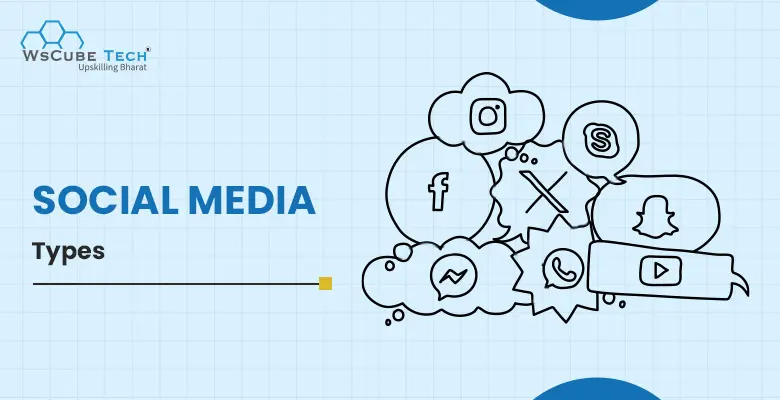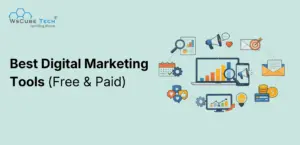Social media is an excellent way to grow your business’s presence online; however, keeping up with new platforms can be tricky. There are more than a dozen types of social media, with more popping up daily. But fear not; understanding these platforms can empower you to make informed decisions and potentially make your brand a household name. By staying updated, you can avoid putting your efforts toward a dying platform while the next big thing passes you by.
In this blog, we will show you different types of social media and guide you in deciding which ones will be best for your business. We will help you narrow your target audience and determine which platforms can enhance your brand and attract more followers. You are not alone in this journey; we are here to support you.
Different Types of Social Media Platform
Keep scrolling to explore the kinds of social media platforms that could help you build social media strategies for your business:
1. Social Networking
Social networking sites allow people to connect through a shared online space. Viewers can share, like, comment on posts, and follow other users and businesses. For brands, social media networking sites offer a promising opportunity to build awareness and create a vibrant community of customers and followers. This can be a robust tool to drive website traffic.
By crafting informative and engaging content, brands can foster relationships with customers and followers that have the potential to lead to conversions. Enroll in an online digital marketing course and learn from the experts to take your social media marketing skills to the next level.

Examples
Facebook, LinkedIn, Instagram, X (Twitter), and Snapchat
How can brands use social networking sites?
- Post, share, and respond to audience content
- On social networking sites, brands have the unique ability to connect with their audience directly. Whether as friends or fans, this engaged social following can signal clout for marketers and brands alike, empowering them to shape their brand image and message.
- Form communities and discuss relevant news with them

2. Photo and Image Sharing
On social media, visual content not only outperforms written content but also plays a pivotal role in modern brand strategies. A staggering 49% of marketers emphasize the importance of visuals in their social media strategies, underlining the urgency for brands to adopt this trend.
With more than 1 billion monthly active end users, Instagram has become a powerhouse for photo and image sharing. Its user-friendly interface and popularity make it an ideal platform for brands to curate and share high-quality, creative visuals that tell their unique story.

Examples
Instagram, Snapchat, Pinterest and Imgur
How can brands use photo and image-sharing sites?
- Post high-quality, creative images illustrating your brand values
- Curate and promote user-generated content through branded hashtags
- Engage with customers and followers in real-time
Also Read: 20 Advantages and Disadvantages of Social Media in 2025
3. Video Sharing Sites
Most social media users prefer video to any other kind of content. Like image-based social sites, video hubs like Vimeo and YouTube attract visitors through visual content.
Video content is a powerful tool for educating your audience. Unlike other forms of content, videos require less effort for viewers to absorb. There's no scrolling or reading—just watching. This makes videos the optimal medium for sharing how-tos and tutorials, which are the cornerstones of social video content.

Examples
YouTube and Vimeo
How can brands use video-sharing sites?
- Use video to demonstrate how your product/ service works
- Share user's success stories and testimonials
- Create how-to tutorials and guides related to your industry
- Highlight company culture with behind-the-scenes footage
4. Audio Sharing Sites
Audio-sharing sites became well-known during the COVID-19 pandemic. Stuck at home with Zoom fatigue, people searched for a more accessible way to consume content, and audio-only proved the solution.
Social apps like Clubhouse provide users with a distinct way to connect with others and share ideas.
Examples
Twitter Spaces, Clubhouse, and Facebook Live Audio Rooms
How can brands use audio-sharing sites?
- Share behind-the-scenes content, like interviews with company leaders and employees
- Host live and Q&A events with users or experts in your industry
- Take listeners on a journey by sharing vignettes or audio stories
5. Live Streaming Apps
Live streaming apps let users share real-time videos with their followers. This content is often authentic and unedited, giving viewers an extraordinary behind-the-scenes glimpse into the person streaming's life.
The live-streaming market is booming, and stream everything from product launches and concerts to eSports and beyond.
Examples
Facebook Live, YouTube Live, Twitch and UStream
How can brands use live streaming apps?
- Build anticipation for forthcoming products or events with live teasers
- Give viewers a candid look at your brand
- Boost sales by offering exclusive deals and discounts to viewers tuning in live
6. Social Messaging Apps
Social messaging apps are a type of social media platform that enables users to communicate in real-time. WhatsApp, one of the most prominent messaging apps, has over 200 billion monthly users.
While messaging apps like WhatsApp aren't traditionally considered marketing tools, they can be powerful ways to reach and engage your target audience. Brands use them to offer customer service, make product recommendations, and even make sales.
Examples
Twitter DMs, Google Business Messenger, Facebook Messenger, WhatsApp and WeChat
How can brands use social messaging apps?
- Use chatbots to answer users' questions
- Release automated coupon codes or discount offers
- Make use of Smart Inbox to monitor all incoming messages and conversations in one place
- Create a private group for loyal followers and consumers
Also Read: Top 17 Social Media Marketing Tools With Features and Prices
7. Disappearing Content Apps
Disappearing content, or ephemeral, refers to content that only exists briefly before it expires or is no longer available. Snapchat has popularized this format, but other platforms like Facebook, Instagram, and WhatsApp provide similar features.
This social media marketing type is an excellent way to add buzz and urgency to your marketing campaigns and help you connect with younger audiences. A digital marketing course offers you the tools and strategies to outstretch your marketing goals, upsurge your online presence, and direct traffic to your website or user profile.
Examples
Instagram Stories, Snapchat, and Facebook Stories
How can brands use disappearing content apps?
- Promote time-sensitive sales and discounts
- Encourage your audience to share their disappearing content
- Design behind-the-scenes content to give your audience a sneak peek into your brand
Must-Know Concepts in Social Media Marketing
| Social Media Marketing Career | Latest Social Media Trends |
| Social Media Marketing Tools | Social Media Project Ideas |
| Social Media Marketing Benefits | Social Media Advantages and Disadvantages |
8. Social Shopping Networks
Social shopping has become extremely popular recently. Most social media platforms allow users to browse and purchase products without leaving their apps.
This social media marketing type is convenient for consumers and gives brands a peculiar opportunity to sell their products directly to their intended users. 60% of viewers say they find new products on Instagram, and 75% of Pinterest buyers say they always shop in the app. Social shopping holds ample value for businesses.
Examples
Facebook for Business, Shopify, Instagram Shop, and Pinterest Shoppable Pins
How can brands use social shopping networks?
- Make use of Pinterest Shoppable Pins to tag products in your posts and enable users to purchase them without leaving the app
- Design a Facebook shop and link it to your Facebook and Instagram pages
- Tag products in Instagram stories and posts and link to your site or other platforms like Shopify
9. Interactive Social Media Apps
These social media types focus on user interaction and engagement. They encourage users to communicate through competitions, gamification, or voting.
For example, Snapchat’s Lenses feature allows users to add augmented-reality filters to their videos and photos.
Examples
Instagram Stories, Snapchat, TikTok, Tumblr and Weibo
How can brands use interactive social media apps?
- Create a branded Snapchat Lens or Filter for your audience to play with
- Be active in the comment section of Weibo Stories
10. Discussion Forums
These online platforms offer a massive array of topics for discussion, from the serious to the lighthearted. For instance, Reddit boasts a subreddit community for almost every conceivable subject, spanning from the complexities of cryptocurrency to the simplicity of jokes.
For brands, these forums are platforms for engagement and invaluable sources for social listening. They provide a unique opportunity to learn what people say about your brand and gather feedback from existing and potential customers.
Examples
Reddit, Quora, and Stack Overflow
How can brands use discussion forums?
- Crowdsource product feedback and ideas in pertinent forum threads
- Provide customer support in forums where your target audience discusses your brand
- Participate in subreddits and answer questions about your industry
11. Microblogging Platforms
A type of social media marketing, Microblogging allows users to post short updates or messages. Twitter is the best example of Microblogging, enabling end users to tweet in 140 characters or less.
While X (Twitter) once dominated microblogging, platforms like Tumblr and LinkedIn have also become popular microblogging sites.
Examples
Twitter, Tumblr, Pinterest and LinkedIn
How can brands use microblogging platforms?
- Use hashtags to join conversations about your product or industry
- Provide customer support or answer questions in microblogs or comments
- Share articles, news, and other content relevant to your followers
Also Read: Top 15 Benefits of Social Media Marketing (Advantages & Pros 2025)
12. Community Blogging Sites
This type of social media site allows people to share ideas, write articles, and collaborate on projects. Most community blogging sites concentrate on a specific topic or niche, making them an excellent resource for discovering new content ideas and connecting with other like-minded people. They also tend to have engaged users, which is beneficial for promoting your brand or product.
Examples
Medium, GrowthHackers, BlogEngage and DoSplash
How can brands use community blogging sites?
- Generate traffic back to your blog
- Connect with other bloggers in your niche
- Curate content around a specific topic
13. Social Review Sites
Most of the consumers use online reviews to make purchase decisions. Moreover, many of them trust online reviews, just like personal recommendations.
Managing, gathering, and engaging with your online reviews is vital to success in many industries today. Using Sprout Social, you can post directly to your Google Business Profile.
Examples
Google Business Profile, Amazon, Yelp and Facebook
How can brands use social review sites?
- Monitor and respond to reviews promptly
- Consider negative reviews as an opportunity to upsurge your business
- Encourage happy customers to leave positive reviews
14. Social Curation and Bookmarking Sites
Social bookmarking lets you save web pages to revisit later. These sites also let users share bookmarks with others, add annotations, and find new content.
Use this type of social media platform to curate content for your customers or team. It’s also a great place to create a content bucket to repurpose across your social media channels.
Examples
Pocket, Digg, Pinterest, and Mix
How can brands use social curation and bookmarking sites?
- Look for relevant content to share with your audience and save it for later
- Generate a content bucket that your team can use on social media
- Collect customer research and insights

Things to Consider While Deciding The Right Social Media Type
You will unlikely have the time and resources to increase your business’s presence on every social media platform. The best thing you can do is figure out which platforms are ideal for your business.
Here are the things to consider when deciding which social network types are best for your brand:
- Identify your intended audience and understand where your potential customers are most active.
- Define what you want to achieve with your social media presence.
- Evaluate the characteristics of different social media platforms.
- Select social media websites that align with the kind of content you create.
- See where your competitors are successful.
- Consider advertising costs and the overall budget.
- Experiment with a few platforms initially and analyze performance before committing.
FAQs on Types of Social Media
The five most extensive social media platforms are YouTube, WhatsApp, Facebook, Instagram, and WeChat, with a collective monthly active user base of 10.19 billion.
Social media has several significant benefits, including connecting with others, sharing expertise, boosting visibility and brand awareness, and gaining market insights.
Social media marketing offers unique advantages that differentiate it from traditional marketing methods. It allows:
- brands to connect with a vast audience
- engage with customers in real time, and gather insights from direct feedback and social listening
- increase brand visibility and recognition
- drive targeted website traffic
- enhance customer loyalty through regular interaction
Conclusion
Each social media platform serves unique needs and social purposes. By tapping into all these platforms and leveraging their strengths, businesses can effectively reach their desired audience and achieve their business goals.
There are no set rules or prescribed ways to use these platforms. This flexibility lets you experiment and adapt your strategies to stay pertinent and responsive to your audience. Content can be repurposed across diverse platforms, ensuring your brand is consistent. Try out different types of social media and discover which ones work best for your business.
Explore Our Free Courses




Leave a comment
Your email address will not be published. Required fields are marked *Comments (0)
No comments yet.